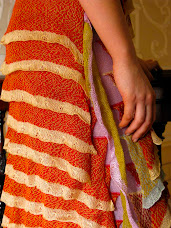 Cotton is an extremely water intensive crop, and processing this fiber also has environmental consequences, contaminating fresh water supplies. Continuous cultivation of cotton in the Aral Sea basin of Uzbekistan has decreased the actual surface area of the sea which has been diminished 45% because of the diversion of the two rivers for cotton production. Massive amounts of pesticides are used in cotton agriculture, but even if cotton is cultivated organically, is it still viable as a sustainable product? Cotton Inc. denies any such impact from cotton cultivation. see: http://www.cottoninc.com/Water-Management/Cotton-Irrigation-Systems/
Cotton is an extremely water intensive crop, and processing this fiber also has environmental consequences, contaminating fresh water supplies. Continuous cultivation of cotton in the Aral Sea basin of Uzbekistan has decreased the actual surface area of the sea which has been diminished 45% because of the diversion of the two rivers for cotton production. Massive amounts of pesticides are used in cotton agriculture, but even if cotton is cultivated organically, is it still viable as a sustainable product? Cotton Inc. denies any such impact from cotton cultivation. see: http://www.cottoninc.com/Water-Management/Cotton-Irrigation-Systems/
Apparel and home furnishings manufacturers are beginning to use recycled fiber. Jimtex Yarns and Martex Fiber recycle cotton t-shirts to produce the ECO2cotton™ brand. ECO2cotton™ promotes an environmentally responsible product while also reducing landfill and conserving water and energy. Created from new, pre-consumer post-industrial cotton knit cuttings that are discarded during the cut and sew process, the fragments are reprocessed and blended into fiber similar to new cotton that can be re-spun into yarns or mixed with other fibers.
see: http://www.jimtexyarns.com/index.php?option=com_content&task=view&id=13&Itemid=32Teijin
One firm, Teijin Fibers Ltd. recycles uniforms and curtains to create fibers. Teijin Group established the first chemical recycling technologies for fibers, films and bottles and organized EcoCircle.
Landfill is controlled in Japan by steep pricing, and the sayonara or moving sale is common, simply to avoid such charges. Recycling clothing via resale is substantial in Japan and other countries. According to the US Textile Recycling Agency it is estimated that each person in the US generates over 60 pounds of textile waste annually, although over 90 percent of this could be recyclable, only 15% is recycled via re-usu. Adverts for pre-worn clothing are imminent.
Sarah Ratty designs ensembles from recycled jumpers (pullovers). Do Redo recycles sweaters donated by the Salvation Army by felting, then transforming the textiles into garments that are inspired by today’s trends as well as traditional design. Designers Katarina Brieditis and Katarina Evans recycle textiles, knitting, crocheting and embroidering to create sustainable garments. Their manifesto states: "Do Redo is a protest against society's tendency toward conspicuous consumption. Take a worn out wool sweater, wash it in hot water, grab a pair of scissors and give it new life! You can find inspiration anywhere-on the street, in a fasionable boutique or on the Web. And don't forget to look in museums, where you can find a treasury of old textiles to inspire you. We think handicraft can change the world, or at least make it a more pleasant place." Their book, Do Redo: The Art of Slaughtering a Sweater provides basic instructions on how to knit, embroider and crochet. Fashion reporter Anna-Stina Lindén Ivarsson wrote the text and chose the pictures and references to current trends and yesterday's fashion. Published by Alfabeta Publishers, Stockholm, Sweden. see: http://www.doredo.se/display.aspx?lang=2&tid=1&id=2
Luz Claudio's white paper, Waste Couture: Environmental Impact of the Clothing Industry explores the actual statistics of clothing re-use and discovered that only one-fifth of all clothing donated to charities is directly used or sold in their thrift or retail stores. “There are nowhere near enough people in America to absorb the mountains of castoffs, even if they were given away.” see: http://www.pubmedcentral.nih.gov/articlerender.fcgi?artid=1964887
10 years ago, Sarah F. at the School for the Physical City in NYC was purchasing her clothing by the pound at Domby’s in Williamsburg instead of doing laundry and she may have been prescient, given the environmental impact of laundering. It is estimated 60% of the energy used in the life cycle of a cotton T-shirt is related to postpurchase washing and drying at high temperatures; transportation constitutes only a small portion of the energy profile to produce a cotton product. Why not dry clothes outdoors? For most of the US this is a viable option.
Certainly if one is consuming cotton, organic is preferable, and in order to support fair trade, ecomodista advocates hand knitting, no not in China or Cambodia where wages barely support life, but in one's own home, with one's own hands. Rowan International recently launched its organically grown naturally dyed yarns. Knitting with organic cotton in a fair trade zone--ecomodista may just cotton to cool.
Tuesday, July 8, 2008
cool to cotton
Subscribe to:
Posts (Atom)

construction detail of michael reynolds earthship






